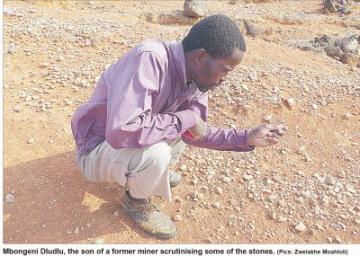ESWATINI SITTING ON E200 BILLION

KHUBUTHA – The idiom ‘sitting on a gold mine’ resonates well with the community of Nhlalabantfu.
This is an area with minerals worth billions of Emalangeni.
Nhlalabantfu, which is situated under the Khubutha Inkhundla, has a deposit of approximately 815 000 tonnes of Tin.
Currently, the price of Tin stands at US$16 340 per ton which is equivalent to E245 100 per tonne. The prices were sourced from Markets Insider.
Mathematically, this means the country has approximately E200 billion worth of mineral at Nhlalabantfu. The exact figure is E199 756 500 000.
This amount is around 10 times of the country’s 2019/2020 national budget which stands at E22.97 billion per annum.
Confirmed
Other tin sites that have been confirmed are at Makhwane Hill, Mahwalala (Southwest of Mbabane) and Mbabane River Valley at Ezulwini.
The deposits were confirmed by the department of geology which is under the Ministry of Natural Resources and Energy.
Acting Chief Geologist Dr Noah Nhleko explained that Tin was last mined in the country in 1982 following the market price collapse.
About the uses of Tin, the geologist said the mineral was used to coat other metals to prevent corrosion, such as in tin cans, which are made of Tin coated steel.
“Alloys of Tin are important, such as soft solder, pewter, bronze and phosphor bronze. A niobium Tin alloy is used for super conducting magnets,” he explained further.
Adding, Nhleko said most window glass was made by floating molten glass on molten Tin to produce a flat surface.
Elaborating, Nhleko said Tin salts sprayed onto glass were used to produce electrically conductive coatings.
“Some tin compounds have been used as anti-fouling paint for ships and boats to prevent barnacles. However, even at low levels these compounds are deadly to marine life, especially oysters. Its use has now been banned in most countries,” he stated.
Accumulate
Quizzed on how tin could be identified, the expert said it was found as cassiterite that it often accumulates in alluvial channels as placer deposits because it was harder, heavier and more chemically resistant than the accompanying granite. Cassiterite is a tin oxide mineral that is usually black or generally dark in colour.
Nhleko pointed out that cassiterite deposits could be easily seen in river banks as placer deposits. The placer deposits could be collected and separated by panning methods.
Minister of Commerce, Industry and Trade Manqoba Khumalo said reopening of KaPhunga mine was an opportunity that needed to be explored.
He said there was a need to conduct a feasibility study which would address a few probabilities.
These include the prospecting of the deposits to determine exactly how much tin was in the ground, he said.
“The investment required to open a successful mine. Also, the business case itself, that is, does the price justify the investment at all? How is the global demand trending?” Khumalo rhetorically asked.
Invest
An expert who asked not be identified, when asked if it was viable to invest in mining tin at Sinceni, explained that it was tricky because there were many variables at play.
“For instance, the method you will use to mine the mineral would depend on the size of the deposit. You cannot come with a large scale mining because it would take about three months – you will not recover your cost.
Scaling
“But if you are a small scale miner, you can mine say E5 million per year scaling to 10 years. In this case, you can make profit because the equipment used would be at a small scale,” he explained.
When told that the value stood around E200 billion, the expert said it was a substantial amount, but it would depend on the capacity of the entrepreneur to handle such a gigantic investment opportunity.
“If your operations are optimised properly, you will make a lot of money,” the expert said.
The geologist concurred with Khumalo that investors should first conduct a feasibility study to determine the mining method to be used.
Aware
Meanwhile, Khubuta Member of Parliament Musa Mlamuli Mabuza said they were aware of the mine.
“We are currently engaging the Ministry of Natural Resources and Energy on prospects of reopening the mine. If we are successful, this will create opportunities for employment,” he said.
Once it is re-opened there will be job creation.
As you are aware that government is faced with a fiscal challenge, this will be an opportunity to resuscitate our economy. His Majesty instructed that every liSwati should work towards resuscitating the economy.




 del.icio.us
del.icio.us Digg
Digg
Comments (0 posted):